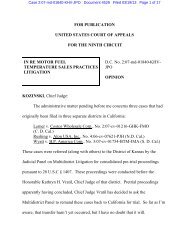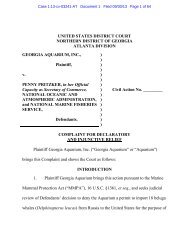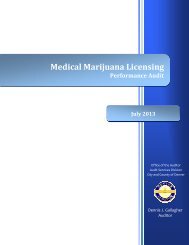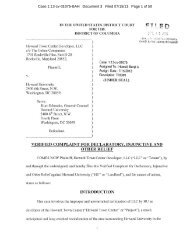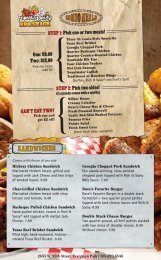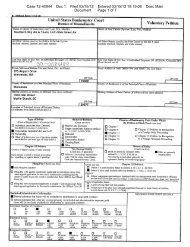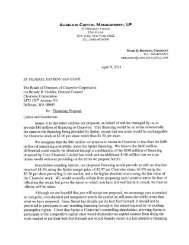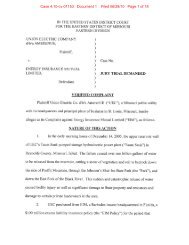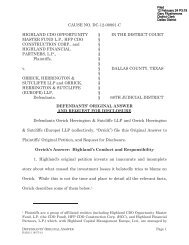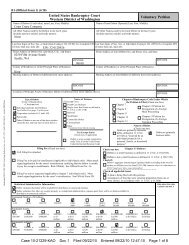Craft Beer Production - The Business Journals
Craft Beer Production - The Business Journals
Craft Beer Production - The Business Journals
You also want an ePaper? Increase the reach of your titles
YUMPU automatically turns print PDFs into web optimized ePapers that Google loves.
WWW.IBISWORLD.COM <strong>Craft</strong> <strong>Beer</strong> <strong>Production</strong>August 2013 1Interest brewing: Increasing popularity willcontinue to drive revenue for craft beer brewersIBISWorld Industry Report OD4302<strong>Craft</strong> <strong>Beer</strong> <strong>Production</strong>August 2013Agata Kaczanowska2 About this Industry2 Industry Definition2 Main Activities2 Similar Industries2 Additional Resources3 Industry at a Glance4 Industry Performance4 Executive Summary4 Key External Drivers6 Current Performance8 Industry Outlook10 Industry Life Cycle12 Products & Markets12 Supply Chain12 Products & Services14 Demand Determinants14 Major Markets15 International Trade17 <strong>Business</strong> Locations19 Competitive Landscape19 Market Share Concentration19 Key Success Factors19 Cost Structure Benchmarks21 Basis of Competition21 Barriers to Entry22 Industry Globalization23 Major Companies23 Boston <strong>Beer</strong> Company24 Sierra Nevada Brewing Company26 Operating Conditions26 Capital Intensity27 Technology & Systems27 Revenue Volatility28 Regulation & Policy29 Industry Assistance30 Key Statistics30 Industry Data30 Annual Change30 Key Ratios31 Jargon & Glossarywww.ibisworld.com | 1-800-330-3772 | info@ibisworld.com
WWW.IBISWORLD.COM <strong>Craft</strong> <strong>Beer</strong> <strong>Production</strong>August 2013 2About this IndustryIndustry DefinitionThis industry includes microbreweriesand brewpubs that produce beer forresale or consumption on premises. Asdefined by the American BrewersAssociation (ABA), a microbreweryproduces up to 6 million barrels(186,000,000 US gallons) of beer ayear. Brewpubs brew and sell beer ontheir premises as well as prepare andserve food. A brewpub may also beconsidered a microbrewery ifproduction has a significant distributionbeyond the premises (75.0% based onthe ABA’s definition).Main Activities<strong>The</strong> primary activities of this industry areBrewing and selling Pale Ale beersBrewing and selling Lager beersBrewing and selling seasonal beersBrewing and selling Stouts and Porters<strong>The</strong> major products and services in this industry areLagersPale AlesSeasonal <strong>Beer</strong>sStouts and PortersSimilar Industries31212 Breweries in the USThis industry primarily produces alcoholic beverages using malted barley and hops.31213 Wineries in the USThis industry produces wines and brandies. <strong>The</strong>se are then packaged in bottles or casks and sold.31214 Distilleries in the USThis industry purchases a variety of ingredients, such as grains and sugar, and manufactures them intospirits (i.e. not beer or wine). <strong>The</strong>se spirits are then bottled and sold.42481 <strong>Beer</strong> Wholesaling in the USThis industry primarily purchases, stores, sells and distributes beer and other fermented malt beverages.44531 <strong>Beer</strong>, Wine & Liquor Stores in the USThis industry sells alcoholic beverages for off-premises consumption.Additional ResourcesFor additional information on this industrywww.brewersassociation.orgBrewers Associationwww.beerinstitute.org<strong>The</strong> <strong>Beer</strong> Institutewww.census.govUS Census Bureau
WWW.IBISWORLD.COM <strong>Craft</strong> <strong>Beer</strong> <strong>Production</strong>August 2013 3Industry at a Glance<strong>Craft</strong> <strong>Beer</strong> <strong>Production</strong> in 2013Key StatisticsSnapshotRevenue$3.9bnAnnual Growth 08-1310.9%Annual Growth 13-187.2%Profit$378.0m Exports$46.9m <strong>Business</strong>es2,439Market ShareBoston <strong>Beer</strong>Company 19.3%Sierra NevadaBrewing Company5.1%% changeRevenue vs. employment growth151050IndexPrice of coarse grains350300250200150100−5Year 05 07 09 11 13 15 171950Year 04 06 08 10 12 14 1618RevenueEmploymentp. 23Products and services segmentation (2013)SOURCE: WWW.IBISWORLD.COMKey External DriversDemand from beerwholesaling13.0%Stouts andportersPrice of coarse grainsPer capita alcoholconsumptionPer capita disposableincomeAccess to credit18.1%Seasonal beers41.0%Pale alesp. 427.9%LagersSOURCE: SOURCE: WWW.IBISWORLD.COMWWW.IBISWORLD.COMIndustry Structure Life Cycle Stage GrowthRevenue VolatilityMediumCapital IntensityMediumIndustry AssistanceLowConcentration LevelLowRegulation LevelTechnology ChangeBarriers to EntryIndustry GlobalizationCompetition LevelHeavyLowLowLowMediumFOR ADDITIONAL STATISTICS AND TIME SERIES SEE THE APPENDIX ON PAGE 30
WWW.IBISWORLD.COM <strong>Craft</strong> <strong>Beer</strong> <strong>Production</strong>August 2013 4Industry PerformanceExecutive Summary | Key External Drivers | Current PerformanceIndustry Outlook | Life Cycle StageExecutiveSummaryDespite an often limited distributionreach and high price points, craft beerhas increased in popularity among USbeer drinkers. Many craft beer operationsare kept small to maintain a focus onquality. Because of their small size,however, they do not have the ability tonegotiate larger supply or distributioncontracts, forcing such breweries tocharge higher prices. During therecession, a consumer shift to drinking athome rather than on premises benefitedcompanies in the industry because it iseasier to place products on retailerHigh market acceptance and low barriers toentry have boosted operator numbersshelves than in restaurants or bars thatoffer a limited selection of alcoholicbeverages. As a result, IBISWorldestimates that industry revenue grew anannualized 10.9% to $3.9 billion duringthe past five years, including anticipatedgrowth of 11.9% in 2013.Increasing market acceptance and lowbarriers to entry make this industryattractive for new businesses. Minimalequipment is required to brew craft beer,and industrial equipment can be boughtready to use. A culture that emphasizeslocally brewed craft beers has alsoencouraged entrants into the industry. Inthe five years to 2013, the number ofenterprises is anticipated to grow at anannualized rate of 10.9% to 2,439 firms.Rampant expansion has also ledcompanies to seek new markets abroad.As a result, exports are estimated toincrease at an annualized rate of 37.3%during the five-year period, reaching$46.9 million in 2013.As a result of high demand justifyingprice increases, the industry is becomingmore profitable. <strong>The</strong> average industryprofit is expected to total 9.6% ofrevenue in 2013. Profitability variesbetween companies, however, becausethe price per unit manufactureddecreases as craft breweries scale upproduction volume. <strong>The</strong> largest craftbrewer, <strong>The</strong> Boston <strong>Beer</strong> Company Inc.,has an estimated operating profit of12.2% of 2013 revenue.During the next five years, the industryis forecast to benefit from brandrecognition and increasing disposableincome. However, growth will slow aslarge brewers increasingly competethrough new branding practices, as wellas through acquiring craft breweries andthus directly removing them from thisindustry. As a result, IBISWorld projectscraft beer production revenue to rise at a7.2% annualized rate to $5.6 billion overthe five years to 2018.Key External DriversDemand from beer wholesalingWholesalers are a crucial link in thesupply chain. <strong>The</strong>refore, craft breweriesneed to carefully plan distribution toinfluence the level of product promotionwithin liquor wholesaling outlets inorder to maximize market share. Manycraft breweries only have localdistribution agreements, which severelylimits the availability of their products.Demand from beer wholesaling isexpected to increase slowly during 2013,posing a potential opportunity to theindustry.Price of coarse grains<strong>The</strong> price of coarse grains tracks theprices of barley, oats and sorghum. Grainis a major input for beer production, sothis driver represents the dominantinputs for craft breweries. Increasinggrain prices pushes up production costs,
WWW.IBISWORLD.COM <strong>Craft</strong> <strong>Beer</strong> <strong>Production</strong>August 2013 5Industry PerformanceKey External Driverscontinuedand, in turn, decrease profit. <strong>The</strong> price ofcoarse grains is expected to increaseduring 2013, posing a potential threat tothe industry.Per capita alcohol consumptionAlcohol consumption can affect craftbeer sales, either positively or negatively.Additionally, consumers’ cultural andattitudinal changes can alter demand forbeer. For example, many people drinkonly in moderation due to personalbeliefs, whether health- or religionbased,reducing alcohol consumptionand, therefore, industry revenue. Percapita alcohol consumption is expectedto increase slowly during 2013.Per capita disposable income<strong>The</strong> level of disposable income affectsspending on industry products, whichare generally more expensive than theirbig-brewery counterparts. When peoplehave more money, they are more likely toconsume premium beer at higher pricepoints, like craft beer, which translates toincreased sales and higher margins forcraft brewers. Per capita disposableincome is expected to increase slowlyduring 2013.Access to creditAccess to credit refers to the borrowingcapacity advanced by a commercial bankto an individual, firm or organization inthe form of loans, cash credit andoverdrafts. Credit allows craft brewers,for instance, to invest in machinery andequipment to begin commercialoperations or expand existing facilities.As access to credit increases, it enablesmore companies to expand operationswithin the industry. Access to credit isexpected to increase in 2013.Price of coarse grains350300Demand from beer wholesaling2.01.5Index250200150% change1.00.50.0100−0.550Year 04 06 08 10 12 14 1618−1.0Year07 09 11 13 15 1719SOURCE: WWW.IBISWORLD.COM
WWW.IBISWORLD.COM <strong>Craft</strong> <strong>Beer</strong> <strong>Production</strong>August 2013 6Industry PerformanceCurrentPerformanceIncreasingly knowledgeable and healthconsciousconsumers are trading up forhigher-quality beers and other alcoholicbeverages. Bulk beverage sales declinedas a result of health-consciousindividuals switching to high-qualityproducts in smaller quantities.<strong>The</strong>refore, although per capita alcoholconsumption stayed relatively constantduring the past five years, consumersshifted away from big-name beers likeBudweiser, Miller or Coors andsubstituted them with regional andhigh-quality industry products. Thistrend has stimulated growth in the craftbeer segment because consumers arewilling to pay more for a smaller quantityof high-quality beer.Although disposable income dippedin the past five years, it resulted in ashift toward drinking at home. This shiftenabled many consumers to continuepaying for higher-end beers becausethey did not have to tip servers or pay% changeIndustry revenue151050−5Year 05 07 09 11 13 15 17higher on-premises prices. As a result,industry revenue is expected to grow atan annualized rate of 10.9% to $3.9billion in the five years to 2013,including 11.9% growth in 2013 spurredby rising disposable income enablinghigher prices and increasing industryproduction volume.19SOURCE: WWW.IBISWORLD.COMProfit challenges<strong>Craft</strong> beer producers are often not ableto take advantage of mass productionand do not have the ability tonegotiate the larger supply contractsthat come with economies of scale.<strong>The</strong>refore, they are disproportionatelyexposed to fluctuations in the supplyof inputs, and must charge higherprices than big beer companies to stayin business. During the past five years,a shortage of hops and high,unpredictable grain prices aggravatedthis. In the five years to 2013, theworld price of coarse grains isexpected to grow at an annualized rateof 5.4%.In response to increasing grainprices and enabled by rising demand,brewers increased prices of theirproducts. Many brewers also boostedrecycling and energy-saving efforts tocut costs. For example, major companySierra Nevada Brewing Companyinstalled solar panels in 2008 andcontinually recycles waste materials. Ascraft breweries produce a highervolume of beer, they are better able tonegotiate bulk prices for inputs and canalso afford to implement advancedtechnologies that decrease per-unitcosts, which enabled profit to expand to9.6% of industry revenue in 2013.Attractiveopportunity<strong>The</strong> craft brewing industry hasconsistently attracted new businessesthanks to low barriers to entry. Brewingcraft beer is a cottage industry, meaningit can be done from one’s living room.Although industry enterprises only
WWW.IBISWORLD.COM <strong>Craft</strong> <strong>Beer</strong> <strong>Production</strong>August 2013 7Industry PerformanceAttractiveopportunitycontinuedinclude businesses that sellcommercially, the number is expandingas the number of people interested in thebusiness of brewing beer continues torise. Also, most craft breweries aresmaller, regional entities that producehigh-quality products and can rely onword-of-mouth promotion to generateadequate demand that matches theirlimited production capabilities.During the past five years, the industrybenefited from high unemployment,which reduced the opportunity costs ofstarting a brewery for some entrants. USunemployment increased at an averageannual rate of 7.6% in the past five yearsand remains at a significant 7.6% of theworkforce in 2013. A tight lendingenvironment limited some businessexpansion, but overall access to creditrose at an annualized rate of 0.8% duringthe five years to 2013. <strong>The</strong> number ofcraft brewers is estimated to rise at anannualized rate of 10.9% annualized to2,439 enterprises during the samefive-year period.As the number of craft breweriesgrew steadily during the past five years,many better-established companiesimplemented marketing tactics to boosttheir brand recognition and sales.Increased awareness also helpedstrengthen producer ties withdistributors, especially for moreestablishedcompanies that were eagerto expand production capabilities.Examples of companies that expandedrapidly during the past five yearsinclude New Belgium Brewing Companyand Dogfish Head <strong>Craft</strong> Brewery Inc.Although major players <strong>The</strong> Boston<strong>Beer</strong> Company and Sierra NevadaBrewing Company were alreadydistributed on a national scale in 2008,most companies continue to distributeto regional outlets in 2013. Widerdistribution networks and intensifyingmarketing and sales spending isjustifying higher pay for employees;during the five-year period, wages areexpected to rise an annualized 12.0% to$558.4 million in 2013.Trading up<strong>The</strong> industry is exposed to globaltrends through heightened tradevolumes and an increasing share offoreign ownership with recent mergersamong beverage giants, including ABInBev and Miller Coors. Higher importcompetition from big brands willcharacterize the industry, with importsestimated to hover at 1.6% of demandin 2013.Nonetheless, a weakening US dollarand improved internationaldistribution channels have drivenexport growth, a trend that evencontinued when consumer spendingfell during the recession. Since 2008,exports have expanded at anannualized rate of 37.3% to $46.9million. Exports in 2013 are expectedto account for 1.2% of total industry% changeRevenue vs. exports200150100500−50YearRevenue07 09 11 13 15 17Exportsrevenue, driven almost entirely byrapid growth in nearby Canada andMexico. Shipping costs for relativelysmall quantities of heavy beer bottles19SOURCE: WWW.IBISWORLD.COM
WWW.IBISWORLD.COM <strong>Craft</strong> <strong>Beer</strong> <strong>Production</strong>August 2013 8Industry PerformanceTrading upcontinuedfrom craft brewers are prohibitive tobuilding significant exports overseas,which supports exports’ share of theindustry’s revenue. In comparison,2008’s share of export revenue wasonly 0.4% of total revenue.IndustryOutlook<strong>The</strong> <strong>Craft</strong> <strong>Beer</strong> <strong>Production</strong> industry willbenefit from increasing disposableincome, access to credit and brandrecognition in the next five years.Improving disposable incomes willenable more consumers to fit high-endproducts like craft beer into theirbudgets. To meet rising demand for craftbeer, companies are expected to continueincreasing product prices and expandingtheir production capabilities. Easieraccess to credit will facilitate suchexpansion. IBISWorld estimates thatindustry revenue will grow at an averageannual rate of 7.2% to $5.6 billion in thefive years to 2018, including 13.0%growth in 2014 when disposable incomegrowth is forecast to pick up.Expanding operationsTo meet increasing demand, craft beerproducers have plans to ramp upproduction capabilities. Industrycompanies, including relatively wellknowncraft breweries New Belgium andDogfish Head, are continually expandingtheir on-site facilities. Additionally, NewBelgium and Sierra Nevada areexpanding into new brewing locations by2014. Such expansion is expected tocontribute to 5.9% annualizedestablishment growth to 3,300 in the fiveyears to 2018. In turn, automation isdecreasing the amount of employeesinvolved in beer production. Despitefacility expansion, the number ofworkers is estimated to rise at anannualized rate of 4.2% to 17,790employees in the five years to 2018.Furthermore, speedier industryexpansion will be offset due toacquisitions from major breweries thatare expected to pull craft brewers out ofthis industry.New companies are also expected tocontinue entering the industry toTo meet demand, craftbeer producers plan toramp up their productioncapabilitiescompete. Increasing credit availability isexpected to enable people that previouslybrewed beer as a hobby to enter into theindustry. According to IBISWorldestimates based on data from the FederalReserve, access to credit is projected towell exceed prerecession levels duringthe next five years. Access to credit isforecast to grow at an annualized rate of5.4% in the five years to 2018, comparedto just 0.8% annualized growth duringthe previous five-year period. Newcompany growth will slow, however,because the market is more saturatedthan it was five years ago. <strong>The</strong> number ofcompanies in this industry is projected togrow at an average annual rate of 6.1% to3,287 in the five years to 2018.
WWW.IBISWORLD.COM <strong>Craft</strong> <strong>Beer</strong> <strong>Production</strong>August 2013 9Industry PerformanceGrowing marginsContinued expansion will benefit craftbeer producer profitability. Companiescan take advantage of lower per-unitcosts as the volume of production rampsup. Also, several larger players areplanning to expand into new brewerylocations, which will decreasedistribution costs to nearby markets andthus enable the producers to implementprice increases without boostingconsumer prices. For example,California-based major player SierraNevada has plans to open a brewery inNorth Carolina that will produce thesame beverages but primarily fordistribution to East Coast consumers.Continued expansion willhelp brewers leverage scale,improving profitabilityAlso benefiting producers’ bottomlines, the price of inputs is forecast togrow more slowly. For example, theprice of coarse grains is projected toincrease at an average annual rate of2.5% in the next five years, comparedwith a 5.4% annualized spike in the pastfive years. This growth will helpcompanies expand profitability to anestimated 10.2% in 2018.IncreasinglyinternationalExports are forecast to be a major sourceof industry growth during the next fiveyears because neighboring markets arerelatively untapped by craft breweries. Aweak US dollar, especially compared tothe Canadian dollar, is expected tobenefit craft brewers as they expanddistribution contracts with the northernneighbor. As a result, export growth isprojected to continue at a 35.2%annualized rate to $211.7 million in thefive years to 2018. <strong>The</strong>refore, exports asa share of revenue will more than doublefrom about 1.2% in 2013 to about 3.8%in 2018.Similarly, foreign craft brewers areforecast to enter the US market quickly.Consumers’ curiosity for exotic brews isexpected to drive growth in this categoryduring the next five years, especially asdisposable income expands. As a result,imports are projected to grow at anaverage annual rate of 24.8% to $193.1million in the five years to 2018.
WWW.IBISWORLD.COM <strong>Craft</strong> <strong>Beer</strong> <strong>Production</strong>August 2013 10Industry PerformanceLife Cycle Stage<strong>Craft</strong> breweries are ramping up productionvolume and seeking new marketsCompanies often introduce new productsand many produce seasonal varieties<strong>The</strong> number of companies is escalating% Growth in share of economy2015MaturityCompanyconsolidation;level of economicimportance stableQuality GrowthHigh growth in economicimportance; weaker companiesclose down; developedtechnology and marketsKey Features of a Growth IndustryRevenue grows faster than the economyMany new companies enter the marketRapid technology & process changeGrowing customer acceptance of productRapid introduction of products & brands105<strong>Craft</strong> <strong>Beer</strong> <strong>Production</strong>Quantity GrowthMany new companies;minor growth in economicimportance; substantialtechnology change0Sugar ProcessingWineriesBreweriesDistilleriesWheat, Barley & Sorghum Farming-5DeclineShrinking economicimportance-10-10 -5 0 5 10 15 20% Growth in number of establishmentsSOURCE: WWW.IBISWORLD.COM
WWW.IBISWORLD.COM <strong>Craft</strong> <strong>Beer</strong> <strong>Production</strong>August 2013 11Industry PerformanceIndustry Life CycleThis industryis GrowingThis industry is growing at a much fasterpace than the overall economy. Newproduct introductions and increasingmarket acceptance are propelling thisgrowth. <strong>Craft</strong> beer’s popularity boostedits prominence on many store shelves,which further contributed to growingconsumer awareness. Industry valueadded (IVA), which measures theindustry’s contribution to the economy, isforecast to rise at an annualized rate of8.1% in the 10 years to 2018. Meanwhile,GDP is projected to grow at an averageannual rate of 2.1% per year.Acquisitions within the industry arelimited because most craft breweries donot want to be associated with bigbrewers and, instead, look to developtheir own products. Yet, while manycompanies in the industry purposefullylimit expansion to maintain quality,others are continually introducing newproducts to spur revenue growth. Newcompanies are also entering into theindustry to compete. <strong>The</strong> number ofenterprises is forecast to grow at anannualized rate of 8.5% to 3,287 in the 10years to 2018.



